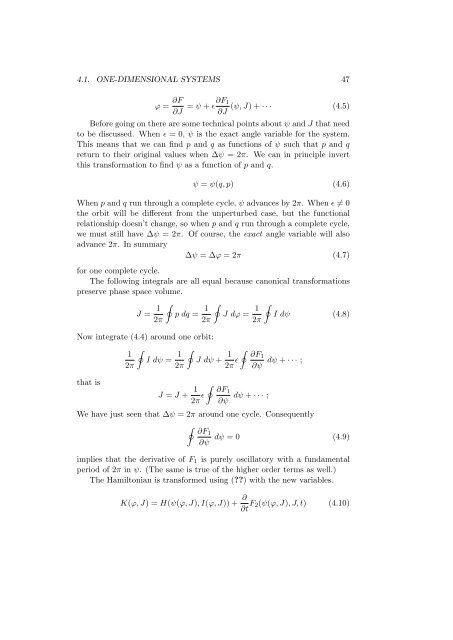Nonlinear Mechanics - Physics at Oregon State University
Nonlinear Mechanics - Physics at Oregon State University
Nonlinear Mechanics - Physics at Oregon State University
Create successful ePaper yourself
Turn your PDF publications into a flip-book with our unique Google optimized e-Paper software.
4.1. ONE-DIMENSIONAL SYSTEMS 47<br />
φ = ∂F<br />
∂J<br />
= ψ + ϵ∂F1 (ψ, J) + · · · (4.5)<br />
∂J<br />
Before going on there are some technical points about ψ and J th<strong>at</strong> need<br />
to be discussed. When ϵ = 0, ψ is the exact angle variable for the system.<br />
This means th<strong>at</strong> we can find p and q as functions of ψ such th<strong>at</strong> p and q<br />
return to their original values when ∆ψ = 2π. We can in principle invert<br />
this transform<strong>at</strong>ion to find ψ as a function of p and q.<br />
ψ = ψ(q, p) (4.6)<br />
When p and q run through a complete cycle, ψ advances by 2π. When ϵ ̸= 0<br />
the orbit will be different from the unperturbed case, but the functional<br />
rel<strong>at</strong>ionship doesn’t change, so when p and q run through a complete cycle,<br />
we must still have ∆ψ = 2π. Of course, the exact angle variable will also<br />
advance 2π. In summary<br />
∆ψ = ∆φ = 2π (4.7)<br />
for one complete cycle.<br />
The following integrals are all equal because canonical transform<strong>at</strong>ions<br />
preserve phase space volume.<br />
J = 1<br />
2π<br />
<br />
p dq = 1<br />
2π<br />
Now integr<strong>at</strong>e (4.4) around one orbit:<br />
th<strong>at</strong> is<br />
<br />
1<br />
2π<br />
I dψ = 1<br />
<br />
2π<br />
<br />
J dφ = 1<br />
<br />
2π<br />
J dψ + 1<br />
2π ϵ<br />
<br />
∂F1<br />
∂ψ<br />
J = J + 1<br />
2π ϵ<br />
<br />
∂F1<br />
∂ψ<br />
dψ + · · · ;<br />
I dψ (4.8)<br />
dψ + · · · ;<br />
We have just seen th<strong>at</strong> ∆ψ = 2π around one cycle. Consequently<br />
<br />
∂F1<br />
dψ = 0 (4.9)<br />
∂ψ<br />
implies th<strong>at</strong> the deriv<strong>at</strong>ive of F1 is purely oscill<strong>at</strong>ory with a fundamental<br />
period of 2π in ψ. (The same is true of the higher order terms as well.)<br />
The Hamiltonian is transformed using (??) with the new variables.<br />
K(φ, J) = H(ψ(φ, J), I(φ, J)) + ∂<br />
∂t F2(ψ(φ, J), J, t) (4.10)
















